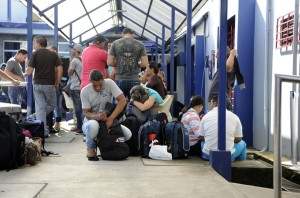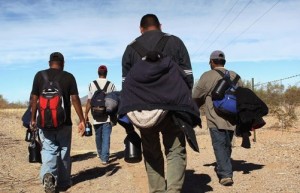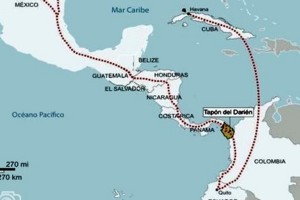OPINION: IN CUBA IS NOT AN EXODUS, IS A FORCED MIGRATION .
In Cuba the regime is creating a forced migration, not an exodus; Expulsion is a middle stratum, not an escape; and it is a humanitarian crisis, not a political or economic migration character.
.. In Cuba the regime controls the entry and exit of his subjects, so these people have express permission from the government to leave the country. Raul Castro is running a deliberate national direct attack civilians, to use as weapons in international politics, and as an indirect attack on the countries receiving the Cubans.
With this action, the leader hides the internal conflict between the government and the population, its refusal to improve the lives of Cubans, and diverts attention from the national to the international field with the calculation of other countries accept Cuban and contribute to subsidize this model of government, as has happened before.
..the “Cuban model” is to use financial backers to support the regime and the regime in turn can continue subjecting the population to a survival economy. Those who attempt to change the acceptable public economic or social behavior, become “enemies” internal state. The regime harasses with inspections, fines, jail, taxes, confiscation of goods, low-paying jobs that do not match or professional capacity. All of which amounts to a state of persecution. The deportation is a consequence of the above.
The propaganda campaign called “economic update” will not change the “model” used since 1965. The update has been questioned by the Catholic Church and by some economists of the regime itself. Both sources have expressed concern about the human cost of the process, in particular the urgency and frustration of the population. More than two years ago, the Catholic Church said the upgrade picked “long coveted demands by the population”. The bishops said they wanted to see “the beginning of a long process of broader reforms for the good of the people and the new generations of Cubans.” “We experienced pressure on citizens regarding these aspirations,” said the bishops according to this newspaper.
Meanwhile, economists expressed similar concerns last year. Omar Everleny Perez said: “It took three years and a few months implementing guidelines and end of the chain, the customer, the employee, do not see results.” Economist Oscar Fernandez Estrada said: “If they were given more space [to small businesses and cooperatives], especially in productive activities and not of services exclusively, could help to expand employment and economic growth.”
Another economist who was not identified said: “I think the majority of Cubans are realizing that there is much that needs to happen, and they are increasingly frustrated by the lack of visible action and negative decisions,” he reported also this newspaper.
..this Is important to note that these expressions of supporting organizations, and officials of the regime are produced in September 2013 and 2014. That is, long before the resumption of relations with the US. So it is incorrect to say that the immigration crisis is the result of fear of the repeal of obsolete Cuban Adjustment Act, as noted some news. Migration is part of a plan by the regime to eliminate people who do not want to use or allow them to work on their own and to intimidate other countries to take responsibility for the lives of those Cubans.
Emigration Policy or economic? It is worth reflecting on those terms, but what I am saying here is something worse: it is a humanitarian catastrophe made by the regime to benefit from other countries and hide their conflicts with the population. One problem may be political, social or economic, but when a government as “resolved” throwing thousands of people to cross borders to other countries makes it an attack against humanity because it has stopped these people see in humans.
Last year more than 43,000 Cubans came to the United States, as published in this newspaper, while The New York Times estimated 100,000 in the past two years. Those interested in the welfare of these desperate migrants and stop Castro’s hand in these expulsions must explain that this migration is a manufactured humanitarian catastrophe; the cause must be placed in denial of freedom for Cubans take own decisions; should explain the pattern of forced migration with the arrangements of the island extorts democracies.
Agencies / DDC / Soren Triff, Boston / Excerpts / InternetPhotos / TheCubanHistory.com
The Cuban History, Hollywood.
Arnoldo Varona, Editor.
OPINIÓN: EN CUBA NO ES UN ÉXODO, ES UNA MIGRACIÓN FORZOSA.
En Cuba el régimen está creando una migración forzosa, no un éxodo; es una expulsión de la capa social media, no una huida; y es una crisis humanitaria, no una migración de carácter político o económico.
.. En Cuba el régimen controla la entrada y salida de sus súbditos, así que estas personas tienen autorización expresa del Gobierno para salir del país. Raúl Castro está ejecutando un deliberado ataque directo contra civiles nacionales, a quienes usa como armas de la política internacional, y como un ataque indirecto contra los países que reciben a los cubanos.
Con esta acción, el líder oculta el conflicto interno entre el Gobierno y la población, su rechazo a mejorar la vida de los cubanos, y desvía la atención del terreno nacional al internacional con el cálculo de que otros países acepten a los cubanos y contribuyan a subsidiar este modelo de gobierno, tal como ha sucedido otras veces.
..El “modelo cubano” consiste en utilizar socios capitalistas para sostener el régimen y que el régimen a su vez pueda seguir sometiendo a la población a una economía de supervivencia. Quienes intentan cambiar la conducta pública aceptable, económica o social, se convierten en “enemigos” internos del Estado. El régimen los acosa con inspecciones, multas, cárcel, impuestos, confiscación de mercancías, trabajos mal remunerados o que no concuerdan con la capacidad profesional. Todo lo cual equivale a un estado de persecución. La expulsión del país es una consecuencia de lo anterior.
La campaña de propaganda llamada “actualización económica” no va a cambiar el “modelo” usado desde 1965. La actualización ha sido cuestionada por la Iglesia Católica y por algunos economistas del propio régimen. Ambas fuentes han expresado preocupación por el costo humano del proceso, en particular la urgencia y la frustración de la población. Hace más de dos años, la Iglesia Católica expresó que la actualización recogía “demandas largamente anheladas por la población”. Los obispos dijeron que querían ver “el inicio de un proceso de reformas siempre más amplias en bien de la población y de las nuevas generaciones de cubanos”. “Experimentamos apremio en la ciudadanía con respecto a esas aspiraciones”, dijeron los obispos según este mismo diario.
Por su parte, los economistas expresaron el año pasado preocupaciones similares. Omar Everleny Pérez afirmó: “Ya llevamos tres años y unos meses implementando Lineamientos y al final de la cadena, el cliente, el trabajador, no ve resultados”. El economista Oscar Fernández Estrada opinó: “Si se les dieran un mayor espacio [a pequeños negocios y cooperativas], sobre todo en actividades productivas, y no de servicios única y exclusivamente, podrían contribuir a expandir el empleo y al crecimiento económico”.
Otro economista que no se identificó expresó: “Creo que la mayoría de los cubanos se está dando cuenta de que es mucho lo que se necesita que suceda, y están cada vez más frustrados por la falta de acción visible y decisiones negativas”, informó también este diario.
..Es importante notar que estas expresiones de organizaciones acompañantes, y funcionarios, del régimen se producen en septiembre de 2013 y de 2014. Es decir, mucho antes de la reanudación de relaciones con EEUU. Por eso es incorrecto afirmar que la crisis migratoria es consecuencia del temor a la derogación de la obsoleta Ley de Ajuste Cubano, como señalan algunas noticias. La emigración es parte de un plan del régimen para eliminar a las personas a quienes no quiere emplear ni permitir que trabajen por su cuenta y para intimidar a otros países para se hagan responsables por las vidas de esos cubanos.
¿Emigración política o económica? Es válido reflexionar en esos términos, pero lo que afirmo aquí es algo peor: es una catástrofe humanitaria fabricada por el régimen para obtener beneficios de otros países y ocultar sus conflictos con la población. Un problema puede ser político, social o económico, pero cuando un Gobierno lo “resuelve” lanzando a miles de personas a cruzar fronteras a otros países lo convierte en un atentado contra la humanidad porque ha dejado de ver en esas personas a seres humanos.
El año pasado llegaron más de 43.000 cubanos a EEUU, según publicó este diario, mientras que The New York Times calcula 100.000 en los dos últimos años. Los interesados en el bienestar de estos emigrantes desesperados y en frenar la mano de Castro en estas expulsiones deben explicar que esta migración es una catástrofe humanitaria fabricada; deben colocar la causa en la negación de libertad para que los cubanos tomen decisiones propias; deben explicar el patrón de migraciones forzadas con el que el régimen de la Isla extorsiona a las democracias.
Agencies/ DDC/ Soren Triff, Boston/Excerpts/InternetPhotos/TheCubanHistory.com
The Cuban History, Hollywood.
Arnoldo Varona, Editor.



 OPINION: IN CUBA is not an Exodus, is a Forced Migration. + OPINIÓN: EN CUBA No es un Éxodo, es una Migración Forzosa.
OPINION: IN CUBA is not an Exodus, is a Forced Migration. + OPINIÓN: EN CUBA No es un Éxodo, es una Migración Forzosa.


